S. Douglas Cornell - Table of Contents
Exterior
photos /
History - S. Douglas Cornell House
484 Delaware
Avenue, Buffalo, NY
History
Beneath Illustrations
Cornell
Lead Company Source: Moon, James C., ed. "A History of the City of Buffalo and Niagara Falls," Buffalo: The Times, 1896 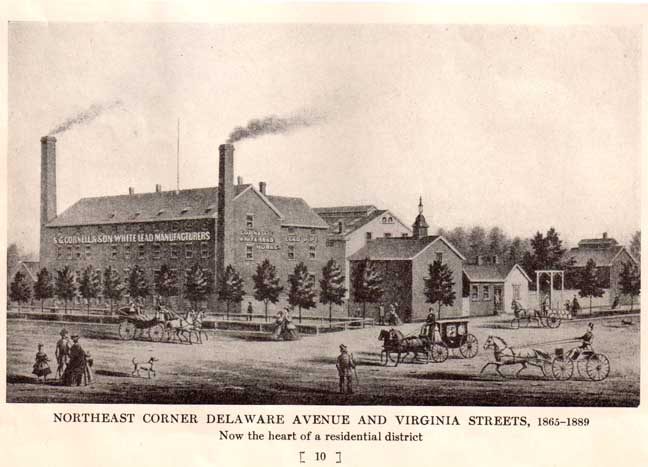 Cornell Lead Co., built in 1865 and demolished five years before Cornell's house was erected, was located across the street from the Cornell house. Source: Views of Old-Time Buffalo, Pub. by The Express, p. 10  Source: Official Catalogue & Guide to the International Industrial Exhibition," 1869  The Midway 1889-1895 ... On the site of Cornell Lead Works which was demolished in 1889 ... 2005 photo |
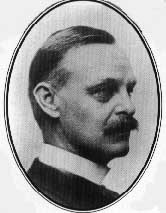 Edward A. Kent, architect of 484 Delaware Avednue - Cornell's house  2008 photo  2008 photo |
November 2017 photos  2017 photo - as are all of the photos below: 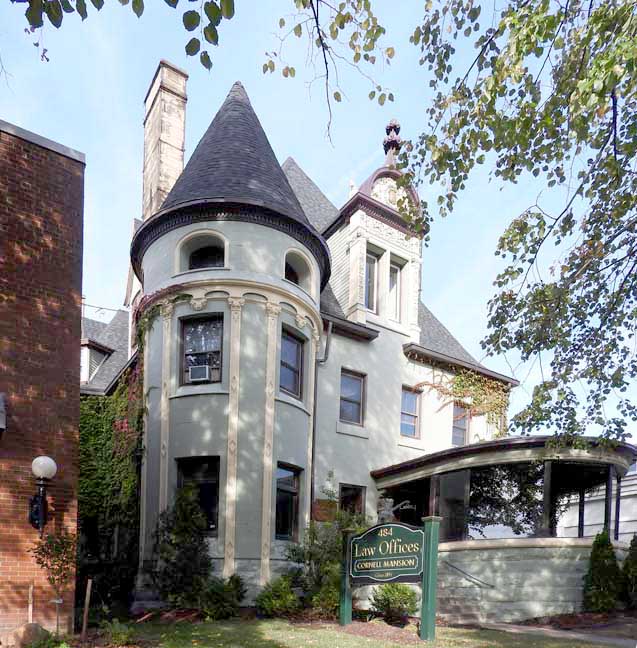 2017 photo ... French Renaissance Revival style ... Tower juxtaposes the main mass of the house  Steamboat style semicircular porch  Conical roof on tower ... Steeply pitched hipped roof and large dormer window with elaborate surround  Steamboat style semicircular porch  Conical roof on tower ... Barrel roof on dormer ... Steeply pitched hipped roof  Two tower details below:  Tower detail #1 - Blind arches above pilasters  Tower detail #2 - Capital features acanthus leaves  Dormer  11 dormer details below: 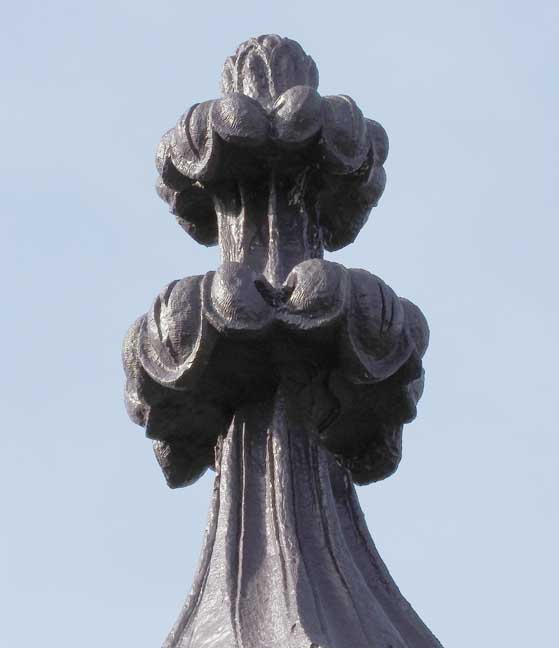 Dormer detail #1 - Finial atop barrel roof  Dormer detail #2 - Finial silhouettedd against cloudy sky  Dormer detail #3  Dormer detail #4 - Ribbons supporting bellflower wreath enclosing a shield  Dormer detail #5 - Frieze detail and supporting pilaster  Dormer detail 6 - Bellflowers flanked by S scrolls  Dormer detail #7 - Capital: Fleurs-de-lis with lower flanking acanthus leaves ... Paneled shaft: Horses flanking palm leaf(?)  Dormer detail #8 - Note fierce looking (guardian?) dog (3 details below:)  Dormer detail #9  Dormer detail #10  Dormer detail #11  Large lower center window was where the original front door was located (detailed below:)  |
North roof  2017 photo - Dormers at different stages for repainting  2017 photo - Half-timbering ... Flared gable roof ... Wooden shingle siding ... Lattice-designed panels 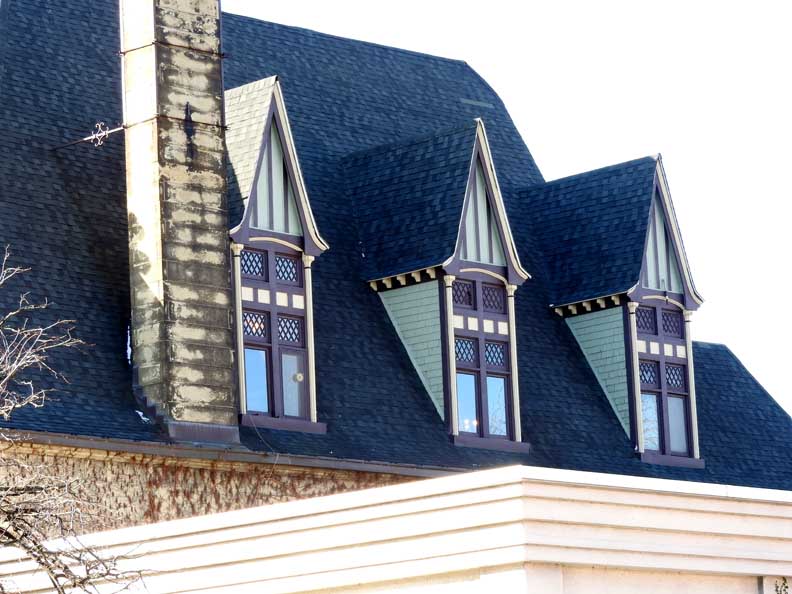 2018 photo - Paint job finished |
History
|
Architect: |
Edward Kent (lived at 514 Delaware Ave. at the time) |
|
Erected: |
1894 |
|
Original owner: |
S. Douglas Cornell
belonged to the eighth generation of Cornells in America, the first
being Thomas Cornell of Essex County, England, born in 1595,
who came to Boston in the 1630s and moved to Portsmouth, Rhode island,
with Roger Williams, where he died about 1655. Samuel G. Cornell was born in 1808 in Glenville, Connecticut. There her and his brothers Peter and Isaac formed the Union White Lead Company, makers of lead pipe, which in 1852 moved to Buffalo as the Cornell White Lead Company. He was a trustee of Hobart and De Vaux and a warden of Saint Paul's. He married Sarah Douglas and they had three children, the first of whom was S. Douglas, born in Fairfield County, Connecticut, in 1830. S. Douglas came to Buffalo with his father and graduated from Hobart in 1860. There he excelled in oratory and dramatics, talents he exercised later as stage manager of the Buffalo Amateurs. After graduation he began an active business career with his father. His connection with the white lead business was broken off for a time, Mr. Cornell going to Colorado as an agent for the examination of gold mines, 1862-64. In this mission he was very successful, and in 1863 he published as a result of his observations a valuable pamphlet entitled, "Prospects of Gold Mining in Colorado." Mr. Cornell's father desired his son's services in his rapidly increasing business, hitherto conducted under his own name; the young man returned from the West and devoted himself to the interests of the firm, which thus acquired the style of S. G. Cornell & Son. The firm was so known until 1867, when it was reorganized as the Cornell Lead Company. Under this name the business was successfully carried on until 1888 when Mr. S. Douglas Cornell retired from active pursuits. Col. Cornell was reputed the handsomest man in the Buffalo of his day. He would walk up the Avenue every afternoon, faultlessly dressed in gray, his hat and his head tipped a bit to one side. Mr. Cornell for many years was connected with the National Guard. N.Y. He enlisted as a private in the Seventy-fourth regiment, in which he soon became a noncommissioned officer. The attention of Brigadier-general William F. Rogers was called to the faithful young man, who was thereupon given a staff appointment as junior aide-de-camp. Mr. Cornell remained on the staff of general Rogers for fifteen years while that officer was a Brigadier-general, and afterwards a Major-general in command of the Fourth division. After serving through various subordinate ranks, Mr. Cornell won the position of assistant adjutant-general and chief of staff, with the rank of colonel. This position he retained until the reorganization of the national Guard, and the abolishment of divisions. The Buffalo Amateurs S. Douglas was a member of the Buffalo Amateurs, and was the stage manager of that organization starting in 1872. Cornell loved to stage amateur theatricals. For this purpose, he had Edward Kent design a fully equipped theater in the attic of his house. The fourth floor was a theater, complete with stage, foot-curtain, scenery, and seating. There the Buffalo Amateurs, including prominent gentry like Maria Love, Porter Norton, Charles Clifton, Townsend Davis, Lars and Eva Sellstedt, Walter, Thomas, and Doctor Charles Cary and their sister Jennie, Carlton Sprague, Cornell himself, his sons Peter and Douglas and daughter Lydia, put on four plays a year in the 1890s and in the early years of the twentieth century. Cornell's granddaughter Katharine, the celebrated actress, developed her attachments for the stage from watching these productions as a young girl. Family In 1862 S. Douglas married Lydia Hadfield of Buffalo and they had three children, Peter Cortelyou, Lydia, and Douglas. His wife was from a distinguished old English family. She loved music, art and literature, flowers and old furniture Mrs. Cornell was the owner of the two white cottages. However, S. Douglas Cornell had them torn down and erected on the site a four-story French Renaissance Revival mansion, the architect of which was Edward Kent of #514 Delaware. Among the visitors to the house was Cornell's friend of many years, President Grover Cleveland. They spent the summer months in Cobourg, Ontario, in a beautiful villa, known as "Hadfield Hurst." E. A. Kent designed some alterations to Hadfield Hurst. (Katharine Cornell was married in her aunt's house in Cobourg at 139 Queen Street in 1921 or 22.) Peter C. studied medicine and married Alice Gardner Plimpton. They resided in Berlin, Germany, while Peter pursued graduate studies in medicine, and their daughter, Katherine, was born there in 1893. Six months later the family returned to Buffalo where they resided on Mariner Street. At thirty-six Peter abandoned his medical practice to manage the Star Theatre. Neither Katherine nor her father had ever lived at #484, but the plays on the fourth floor of the mansion played a part in shaping her career. |
| After his wife died, Cornell sold the mansion to Frances Wolcott. who in the brief time she was there welcomed into it many celebrities, Ann Morgan, Ethel Barrymore,Walter Damrosch, Rachel Crothers, and members of the British aristocracy. At eighty, asked to write an article on the society of her youth, she wrote instead a book, Heritage of Years: Kaleidoscopic Memories, 1851-1889, published in 1932. The author was best known to her friends as the mistress of Hill Crest, her estate in the Genesee Valley. | |
|
Third owner: |
Frances was followed at #484 by Albert
Jay Wight, who had been born in Oswego in 1858. He had previously
lived across the Avenue at #483. His ancestors had come to New England
during colonial days, and a forebear was Silas Wright, United States
Senator and later Governor of New York. At eight Albert came with his parents to Buffalo where he attended PS. 14 and Horace Briggs' Academy He majored in science at Wesleyan, where he suffered an injury in a baseball game which cost him his sight. Returning to Buffalo in 1878, having married Gertrude Bent of Middletown, Connecticut, he went to work at his father's grain handling firm, Preston & Wright, which became Alfred P. Wright & Son two years later. In 1881 he built a house at 242 Linwood Avenue. In 1884 at twenty-six Albert was elected president of the Merchants' Exchange. Though blind, he was regarded as the dean of Buffalo stockbrokers. He was for years the only Buffalonian member of the New York Stock Exchange. As a result, his firm had the largest clientele of any brokerage house in Buffalo. It also had branches in Rochester, Syracuse, Niagara Falls, Bradford, Pennsylvania, and Toronto. He was a world traveler, an art enthusiast, and an authority on matters monetary, which led him to publish in 1933 a novel entitled Red Demon, actually a treatise on the gold standard. In 1905 Wright, Gertrude, and their fifteen year old daughter enjoyed the services of an ethnically diverse staff of servants, two Japanese, two Irish girls, a Canadian girl, and a forty-year old French woman. In the stables lived two English coachmen with their families. Albert Wright was an incorporator of the Country Club of Buffalo in 1889 and belonged to the Buffalo, Ellicott, and Yacht clubs of Buffalo and the Chicago Club. By 1915 he had moved up the Avenue to #512. In 1931 Wright, by then over seventy and a widower, his wife having died in 1925, married in London Tatina Moslova, a young woman in her early thirties whose aristocratic family had fled Russia during the Revolution. The dramatis personae included the Lord Bishop of Norwich, the Earl of Albemarle, and the youthful and beautiful Princess Marie-Helene of Reuss. The wedding party then headed across town to a Russian church where an Orthodox ceremony was performed by Archbishop Seraphim of Paris, brought over for the occasion, before a second cast of supporting actors. Wright died in 1940 at eighty-one at his summer home at Cazenovia. |
|
Later owners: |
As for #484 it had become a rooming house in the '30s and a nightclub in the'40s. It housed the Green Door Antique shop in the '50s, Ziegler Medical Supplies in the 60's and '70s, and a photography studio in the '80s. Attorney Thomas J. Eoannou bought it in 1994 and extensively restored it. |
|
Style: |
French Renaissance |
|
House features: |
The entire top floor was a fully
equipped theater, under a steeply pitched hip roof. A round tower with a witch's cap juxtaposes the main mass while a semicircular porch sets it off at street level. A baroque-style dormer houses single-light windows flanked by very ornate pilasters and capitals. Woodwork on the first floor is of cherry. The marble mantelpiece above the large fireplace of the living room is inscribed "S. Douglas Cornell, 1894." |
|
Neighbors: |
Across the street, where the Cornell family business once operated, are eleven extraordinary structures - The Midway (midway between Niagara Square and Forest Lawn Cemetery on Delaware Avenue). Row houses became popular features of urban streetscapes in the late nineteenth century and Buffalo boasts a number of fine examples of the genre, but seldom do row houses anywhere display the amazing diversity and wealth of feature demonstrated in these examples, |
| Historic
photo: |
1896
photo Art Institute of Chicago (online Jan. 2015) |
Sources:
